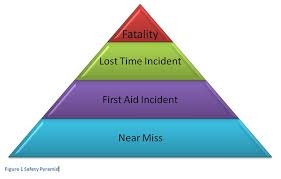Information
-
Conducted on
-
Location
WEEKLY ACCIDENT REVIEW
-
The week of October 28, 2013 Southland Industries reported no new injuries. We’ve made four weeks, a whole month, without an injury!!! Fantastic work everyone. Let’s finish out 2013 injury free.
Close Calls
-
A “close call” or accident without injury is easy to shrug off and forget. But, there is a danger in brushing off accidents that don’t hurt, harm or damage. When a “close call” happens, it should immediately send up a red warning flag that something was wrong, unplanned, unexpected, and could happen again. The next time it happens, it could result in serious damage, injury or death.
For every accident there are usually several contributing factors, most of which can be controlled. The best way to prevent the reoccurrence of an accident is by looking at those “close calls.” By investigating the root causes of an accident, steps can be taken to eliminate the hazard and improve the work system.
Sometimes there are multiple causes for an accident involving: equipment (unguarded machinery), environment (poor lighting or noise level), people (procedures not understood or not followed) or management (allowed shortcuts). Don’t rush to judge. Examine the facts and find what’s missing. Look for immediate and underlying causes. An immediate cause may be an unsafe condition like a mechanical failure or it could be an unsafe action by an employee. The underlying cause could be poor machine maintenance, a missing guard, a crowded work area or a lack of training.
All incidents should be reported to the supervisor so that accident/injury report forms can be completed. Once an investigation is completed, solutions should be sought to prevent the accident from occurring again. Solutions may involve engineering controls, administrative controls, additional training, or increased communication between management and workers.
Workers should daily inspect the work area for unsafe conditions or unsafe actions and, if found, report them to the supervisor. Hazard awareness is key to preventing accidents before they happen. Take steps to eliminate hazards as soon as they are discovered. Learn the real lesson from close calls. They can happen again and again until they cause injury, so tell your supervisor about every accident, no matter how minor it may seem at the time. You never know when an incident may be repeated and result in an injury or even death.
OPPORTUNITY FOR IMPROVEMENT
-
Opportunities for improvement are ALWAYS welcome! Use the Opportunity for Improvement template on iAuditor to submit.
JOBSITE SAFETY CHECKLIST
-
Select date
-
Job Name:
-
Job Number:
-
Checked By:
-
Signature:
1. RECORDKEEPING
-
a. Notices, Posters (5-in1, OSHA Notice, Payroll)
-
b. Emergency Contacts
-
c. OSHA 300 Log
2. PERSONAL PROTECTIVE EQUIPMENT
-
a. In use: Safety glasses, Hard hats, Work boots, Gloves
-
b. Face shields or goggles used for overhead work
-
c. Respirators available
-
d. Welding screens
3. FIRST AID KITS
-
a. Available in gang box and job site trailer
-
b. Stocked adequately with gloves, bandages, and antiseptics
-
c. CPR and First Aid trained personnel
-
d. Medical facility location and contact information communicated
4. SCAFFOLDS
-
a. Competent person certified
-
b. Scaffold grade planking
-
c. Fall protection
-
d. Clear of debris / trash
5. LADDERS
-
a. Free from defects with safety feet, blocked, cleated, or otherwise secured.
-
b. Straight ladders at 1:4 pitch
6. CYLINDERS
-
a. Capped, stored in an upright position
-
b. Oxygen / Acetylene properly separated
-
c. Empty gas cylinders marked
7. TOOLS / EQUIPMENT
-
a. Inspected to ensure safe operating condition
-
b. Hand tools free from defects
-
c. Unsafe / Unusable tools / equipment tagged "Do Not Use"
-
d. Tools / Equipment properly guarded
8. HOUSEKEEPING
-
a. Maintained
-
b. Aisles and exit ways clear with 24" clearance
-
c. Work areas uncluttered and debris removed
9. ELECTRICAL
-
a. Electrical equipment grounded
-
b. Tools double insulated
-
c. Cords in good condition
-
d. Electrical panels covered if energized
10. FALL PROTECTION
-
a. Guard rails, mid rails, toe boards
-
b. Fall restraint systems
-
c. Open sides floors or platforms equipped with standard railing
-
d. Openings (interior / perimeter) properly barricaded or covered
11. FIRE PREVENTION
-
a. Flammable and explosive materials stored safely
-
b. Adequate number of fire extinguishers available with tags and clips
-
c. Vehicles and mobile equipment provided with extinguishers
12. EXCAVATIONS
-
a. Over 4 ft shored, benched, or sloped as required
-
b. Steps or ladders at 25 ft intervals
-
c. Competent person on site
13. HAZARD COMMUNICATION
-
a. MSDS and Labels available
-
b. Employees briefed on HAZCOM
-
c. HAZCOM information poster posted
-
d. Employees familiar with MSDS books and their location
COMMENTS
-
Type comments here or use "Sign" function to write:
-
Write here:
PRE-TASK PLAN
-
Ensure a Pre-Task Plan is completed on paper or via the iAuditor app.
CREW SIGNATURES
-
Add signature
-
Add signature
-
Add signature
-
Add signature
-
Add signature
-
Add signature
-
Add signature
-
Add signature
-
Add signature
-
Add signature
-
Add signature
-
Add signature
-
Add signature
-
Add signature
-
Add signature














